Email personalization strategy guide: Techniques, stats, and examples
Personalization is a tactic used in email marketing campaigns. It combines a specific subscriber’s relevant data and information to target them on an individualized basis. This helps businesses treat customers like individuals, and massively increases email marketing performance.
However, for today’s retailers, email personalization isn’t as simple as addressing your customers by their first name in your subject line. Customers expect a lot more from the brands that vie for their attention — a modern email personalization strategy should include elements like triggered emails, dynamic email copy, personalized product recommendations, optimized send times, and even personalized landing pages that provide subscribers with a more consistent on-site experience.
More retail marketers have started to introduce email personalization consistently, meaning that the standard for personalization will only continue to increase over time. For this reason, it’s important to either kick-start a personalization strategy as soon as possible or ensure your current strategy is as powerful as can be.
Let’s delve into why email personalization is important for retail marketers today, and then take a closer look at how you can sharpen your current strategy.
Why is it important to personalize emails?
The value of personalization in retail marketing has been proven many times over. However, email is an oft-neglected candidate for personalization, despite organizations like the Direct Marketing Association finding that for every dollar spent on email marketing, marketers receive an average of 42 dollars back.
This poses a question: If email marketing is so valuable, why aren’t marketers maximizing the value of their campaigns through personalization?
The answer to this question is simple — 1:1 email personalization is very difficult without access to purpose-built technological solutions, especially in a retail setting. While introducing new technology can be met with hesitation, an effective email personalization strategy will mitigate any costs by increasing open and click through rates, improving email ROI, and even helping to build more loyal relationships with customers.
This is because personalized emails capitalize on relevance, timeliness, and a personal connection with your brand. For instance, you could send your subscribers special offers only if they need extra encouragement to purchase, allowing you to preserve your brand value. Or you could send personalized product recommendations that anticipate a customer’s needs.
In the end, investing in email personalization will lead to a range of benefits, such as:
- Increased relevance — A personalized email will help you stand out in a crowded inbox by differentiating based on non-monetary value while establishing an emotional connection that leads to brand loyalty.
- Better open and click through rates — When a customer opens an email and reads beyond the subject line, you’ll have a better opportunity to connect with them and drive sales.
- Better customer experience — When it’s done right, personalization makes shopping easy. Customers won’t see irrelevant products, allowing them to cut through the noise and find what they need easily.
While these benefits are important, it’s not always easy to illustrate the value of personalized email marketing without using statistics. Let’s take a closer look at how organizations benefit from personalization by the numbers.
Email personalization statistics every marketer should know
Personalization has a measurable effect on many important marketing goals, and email personalization is no exception. Here’s a quick snippet of how retailers benefit from personalizing one-time sends over the course of a year when compared to their static one-time sends.
- Opens — Personalized one-time sends had a 23% increase in open rates.
- Clickthroughs — Personalized emails had an 81.5% increase in clickthrough rates.
- Conversions — Retailers experienced a 133% increase in conversions per email when using personalization.
- Unsubscribes — Personalized emails encouraged a 43.5% year-over-year decrease in unsubscribes.
- Revenue per email — Retailers saw a 142% increase in revenue per email when implementing personalized one-time sends.
[Source: Retail Email Benchmark Report]
When you compare apples-to-apples, it’s clear that email personalization has the potential to exponentially increase the impact of your email marketing campaigns. But let’s take a step back and examine how email personalization conceptually fits into email marketing:
- There are over 3.9 billion global email users, with the number expected to increase to 4.3 billion by 2023 — that’s more than half the global population.
- It’s important to stand out — in 2019, 293.6 billion emails were sent every day, representing 75 new emails in the average inbox each day.
- Using personalization to stand out isn’t easy. According to Forrester, only 12% of brands feel they are good at delivering personalization.
The benefits of email personalization are numerous — but it’s not easy to get started due to the data demands of personalization. Let’s evaluate what kinds of data are important for personalization and outline how your organization can collect the data needed.
How to collect data for personalized email campaigns
Data provides the foundation for any successful email campaign, and this is especially true for personalized email campaigns. It’s important to ensure you have the correct processes in place to evaluate customer, behavior and product data quickly and accurately. However, this may be easier said than done. Here are some tips to help your team get started.
1. Find and eliminate blind spots
The first step of collecting data for campaigns is figuring out what data your team doesn’t have about your customers, solutions or your organization as a whole. The best way to start the search for these blind spots is to find data disconnects that exist across three different dimensions: Consumer blind spots, technological blind spots and organizational blind spots.
Let’s take a closer look at the data dimensions you’ll need to properly personalize your email outreach.
Consumer blind spots
Consumer blind spots refer to aspects of your customers’ identities and behaviors as well as the products in which they are interested . Here’s a brief overview of what each of those elements means:
- Identity — This refers to all the ways you can identify a shopper, including their device ID, email address and cookie information.
- Behavior — Behavior data includes all the activities shoppers take before, during and after the purchase process, such as search and browsing habits, cart abandonment, review activity and more.
- Product — Your email marketing solution should have up-to-date information about all the products in your catalog. This includes purchase criteria and product attributes, such as price drops, co-purchase trends, etc.
By covering these blind spots, you’ll be able to quickly and accurately pair certain customers with certain behaviors and further tie those identities and behaviors to specific product offerings. This ensures you always target customers with the right products for their unique needs.
Technological blind spots
Technology is supposed to help retail marketers do their jobs effectively — and most of the time, it does. However, it’s impossible to make the most of your existing technology without acknowledging the potential for weak spots in your tech stack. Consider the following common technological blind spots.
- Disconnected product catalog – It’s difficult to identify the right product for each shopper when your product catalog isn’t properly connected with your marketing channels and analytical systems. Unless your product catalog automatically syncs with your email marketing solution, something as small as a price change could disrupt your initiatives.
- Latency – It takes most brands 3 to 7 days to cut lists, upload audiences, create visual assets and configure campaigns — but a shopper’s entire purchase cycle can take three days or less. It’s necessary to make all of this data accessible in your email marketing solution as soon as it is available.
- Scaling problems – Scaling your personalized campaigns can be difficult with most personalization solutions. For instance, 80% of personalization widgets default to static product recommendations, leaving most marketers in a difficult position where they must manually enable personalization.
Once you’ve recognized these blind spots, you can better understand where you need to invest your marketing technology spend. This will help you not only create better personalized campaigns but also save money through more strategic spending.
Organizational blind spots
Different departments in your organization tend to have different goals — and sometimes, these goals can end up in direct conflict with each other. This makes accurate decisions around data and technology significantly more difficult. For instance, consider the following scenario at a skincare brand:
- Marketers want to retarget customers who bought skin cream to encourage replenishment.
- Merchandisers want to prime the audience for their next big skincare product launch.
- The eCommerce team wants to send personalized purchase confirmations to make buying seamless.
In this scenario, marketers may be at odds with merchandisers since pitching a brand-new product and encouraging replenishment of an old product can cause dissonance. At the same time, they may not be aware that the eCommerce team is sending personalized product recommendations along with confirmation emails that are creating dissonance for both of their campaigns.
In the end, these blind spots may make all campaigns less effective.
2. Follow the retail data model
Once you’ve collected data to gain visibility among various data blind spots, it’s time to put them into a data model that will provide 1:1 personalization. However, for retailers, a generic data model is missing one big factor — the product catalog.
This is where the retail data model steps in. This data model, designed specifically to enable personalization in a retail setting, unifies customer, behavior and product data. Let’s take a closer look:
- Customer data — Customer data describes who takes an action. For instance, what device are they using? Where are they using it? What is their customer lifetime value?
- Behavior data — Behavioral elements help retailers understand a customer’s typical browsing process, which products/assets they like to interact with and when they tend to engage.
- Product data — This describes what the customer acted on. Personalization sounds like it’s all about the customers — but in retail it’s just as much about what you can offer them and the different attributes of those products.
A quality retail email marketing solution should be able to combine all three sources of data quickly and automatically, helping your personalized campaigns get off the ground with ease.
3. Use a self-learning retail email marketing solution
Retailers should not need to rely on manual workflows. Today, you can cut out much of this work with retail-specific marketing technology. With the right solution, you can combine information from sources like your product catalog, creative assets, and offers and then use those inputs to generate a self-learning campaign that delivers 1:1 personalization.
With artificial intelligence, self-learning campaigns can find the right combination of products, content and offers over time specific to each customer. Accuracy grows over time as new information on engagement, behavior and purchasing patterns comes in. In the end, these smart campaigns will generate the best possible combination of these components by sifting through troves of data in an instant.
Now that we’ve covered what’s necessary to create successful personalized email campaigns, let’s go over some important tips and techniques to help you optimize your strategy.
Tips and techniques for your email personalization strategy
Once you understand what your team needs to launch a personalized email campaign, it’s important to study a few best practices to ensure your campaigns are effective from the outset. Here are some tips and tricks every retailer should consider:
Recognize segmentation is not personalization
Although some guides may use segmentation (or hyper-segmentation) interchangeably with personalization, segmentation and personalization are two distinct practices. While segmentation divides customers by broad factors like location or product interest, personalization creates a unique experience for a single, individual customer.
In practice, segmentation and hyper-segmentation attempt to ensure your emails go to relevant groups — however, this doesn’t entirely prevent you from sending a poorly targeted message. Personalization, on the other hand, all but guarantees your outreach will be relevant since it examines each customer individually.
Addressing customers by name isn’t personalization, either
Remember the first time an email addressed you by name? Chances are, you don’t — it was likely over a decade ago, and since that time, addressing customers by name has become passe. With how sophisticated personalization has become, using a customer’s name in your subject line or copy is no longer a meaningful way to personalize communication. In fact, a growing segment of marketers no longer believe it is a form of personalization at all.
Of course, addressing someone by name is important to capture their attention, so marketers shouldn’t avoid using a customer’s name entirely. However, your personalization strategy needs to go further if you rarely go beyond a customer’s first name.
Personalize the email preview
This simple tip provides an easy way to increase your open rate. Before opening your email, subscribers can only see a subject line, the “from” name and a short snippet previewing the email. A good email marketer will use some form of personalization in each of these three areas to increase engagement. For instance:
- Personalize the “from” name — Depending on the customer, they may prefer opening emails sent from your company (eg. Sweetwater) or a representative (eg. Kyle from Sweetwater). Try A/B testing to learn which is most effective for an individual.
- Personalize the subject line — See if using their first name in the subject line helps — if not, get more creative. Do they prefer when you’re blunt about what’s in the email (eg. “New Seasonal Styles are Here”) or does curiosity make them act (eg. “Are you up-to-date on this summer’s hot trends?”)
- Personalize the snippet — The snippet should continue where the subject line left off to encourage more opens. Provide more hints about what’s in the email and include a specific, personalized CTA on which the individual is likely to click.
Once you personalize your email previews, you’ll find that your subscribers are much more likely to read the contents of your email and click through to your site.
Personalize your email’s copy and images
Once a customer opens your email, reward them with relevant content and product recommendations that make the buying process simple for them. This means you should use everything you know about the customer to ensure you speak to them directly.
You could use their recent online activity, their demonstrated or predicted preferences or even their shoe size to guide your content. If you can neatly tie it into the email’s copy, it has a better chance of resonating with the customer.
Personalize Your eCommerce site experience
Don’t let your ecommerce personalization initiative stop once a customer clicks through your email. Instead, link to a personalized landing page. This will have the benefit of ensuring your landing page content is just as relevant as your email’s content while providing a seamless transition from email delivery to purchase.
Use personalized product recommendations
By tying together customer, behavior, and product data in a retail data model, you can provide relevant product recommendations to your customers. You can use this information to learn who someone is, when and why they shop with your brand and what products they like. The resulting output is a personalized product recommendation that takes into account a customer’s entire identity.
Then, integrate these personalized product recommendations throughout your email – whether it’s right at the beginning, nestled in the middle or included at the bottom. This provides a surefire way to encourage customers to start shopping.
Provide offers on a personalized basis
Some customers need the temptation of a limited-time deal before they make a purchase. This has made discounts and special offers the norm in online retailing — but providing these deals has a serious downside. If you send too many offers to customers, it will erode your brand value over time and lead customers to believe they don’t need to buy your products at full price. It’s also a fast way to eat into margins.
When you use personalization to deliver offers, however, you can choose to only deliver offers based on aspects like discount affinity and loyalty status. Keep in mind these offers don’t need to be discounts — depending on a customer’s unique preferences, they may prefer free shipping, free services or even a gift with purchase as opposed to a coupon for 10% off.
Use automated triggered emails
It’s difficult to deliver personalization at scale without employing some form of automation, such as triggered emails. These emails send automatically when a subscriber takes a particular action or when your product catalog is updated in a way that’s relevant to an individual. This way, your customers always get an email from you when they’re most likely to engage.
To get started with triggered emails, start by determining what your trigger will be — like when a customer leaves an item in their shopping cart without purchasing. Then define rules, like send-time or frequency. Next, create personalized content that aligns with the previously defined trigger.
Optimize send times
It’s important to ensure you send emails to subscribers at the best time of day depending on their individual habits. You can optimize send times based on the time of day, day of the week, day of the month or a certain amount of time after customers take a specific action.
For example, if a customer opens their emails throughout the day but doesn’t click through until after they finish work, you should send them emails after their workday to increase the likelihood that they’ll click.
Keep in mind these habits are subject to change over time, so make sure you have an AI-driven email personalization solution that can continuously test and learn. This will ensure your outreach stays relevant by capturing changes in individual behaviors.
Acknowledge special events
Special events are a great way to capitalize on your relationship with subscribers while solidifying their loyalty. Retailers can send personalized emails for a variety of special events, including anniversaries, holidays, loyalty milestones and more. Be sure to provide dynamic copy and personalized product recommendations within.
By following these tips and techniques from the beginning, you can maximize the positive outcomes of your email personalization campaigns. But to tie your strategy together, let’s look at how some leading brands have used personalization successfully within their email campaigns.
Examples of high-quality personalized emails
Enabling personalization in your email marketing strategy might seem daunting at first, but studying the success of well-known retailers can help your first campaign start off on the right foot. Let’s take a closer look at successful personalized retail email marketing campaigns, and see what insights you can glean from their strategies.
Vans
Vans is an American fashion retailer and manufacturer that primarily sells shoes and apparel. While Vans already has a loyal fan following among young adults, they still use personalization to shore up parts of their strategy. A great example of this is their win-back strategy for at-risk and lost customers:
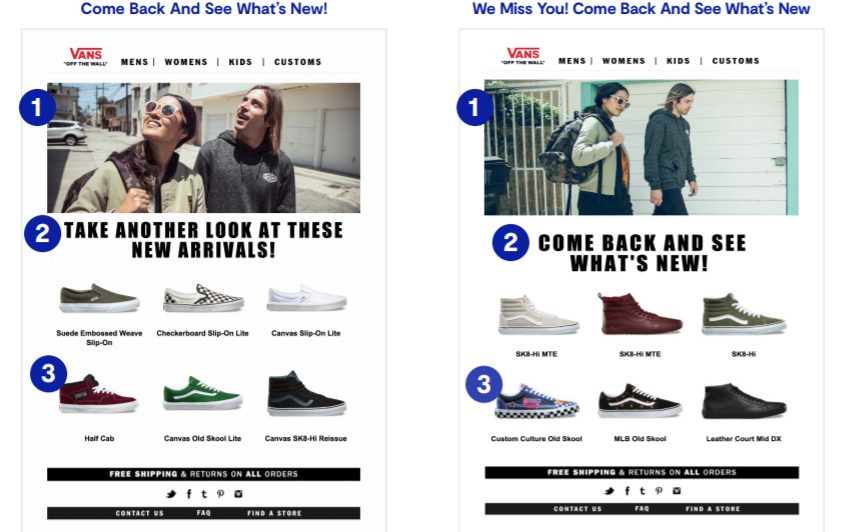
In this image, Vans speaks to customers as individuals using three personalized email elements:
- A unique hero image that captures a certain emotion (in this case, excitement or composure).
- Different messaging depending on if they are at-risk (left) or lost (right).
- Personalized product recommendations based on their predicted affinities.
When integrated into a comprehensive strategy, both of these emails have the potential to spur at-risk shoppers to buy again, putting them back on the path to becoming loyal customers.
Shoes for Crews
Shoes for Crews is a popular retailer for work-safe, slip-resistant shoes that are commonly used by food service personnel, warehouse staff, retail staff and more. Since they cover such a wide swath of industries – all with different footwear requirements — personalization is absolutely essential to their marketing campaigns. Let’s take a look at one of their campaigns:
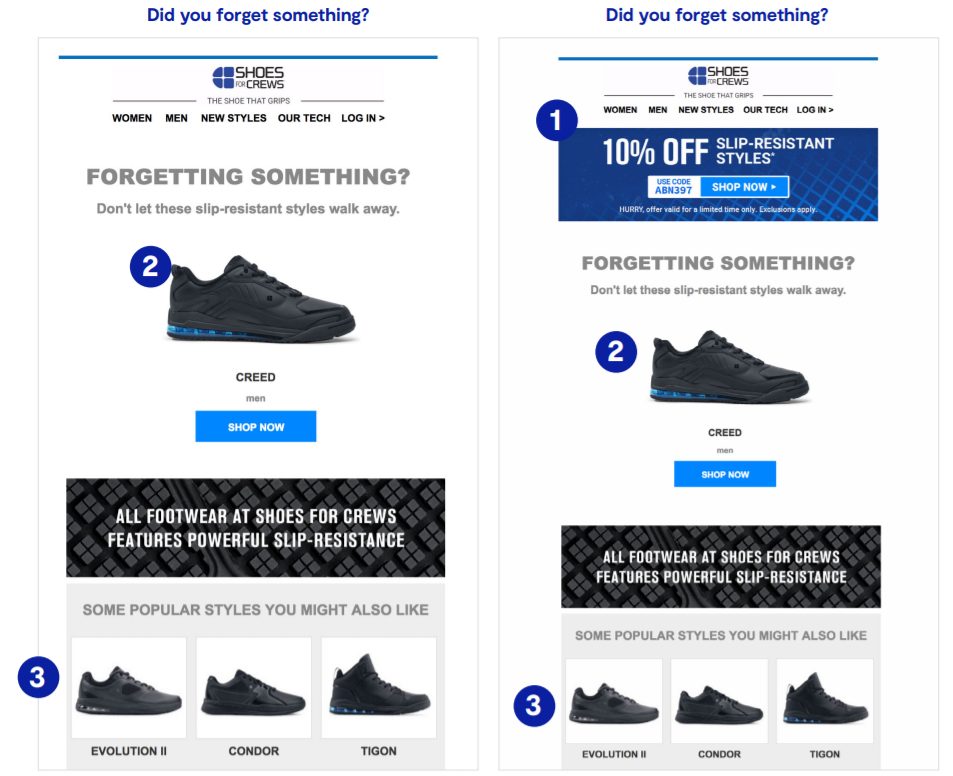
Both of these emails are nearly identical – except for the discount in the second image. For this campaign, Shoes for Crews used discount affinity to differentiate between deal-savvy customers and those who are willing to buy at full price. This approach helps them drive more purchases while preserving their margins.
Evo
Evo is an online retailer that sells outdoor gear and fashion apparel, with a special focus on sports like skiing, snowboarding, biking and surfing. Personalization is crucial for Evo to ensure they target customers with relevant sporting gear – and one way they do this is by tracking a customer’s browsing patterns.
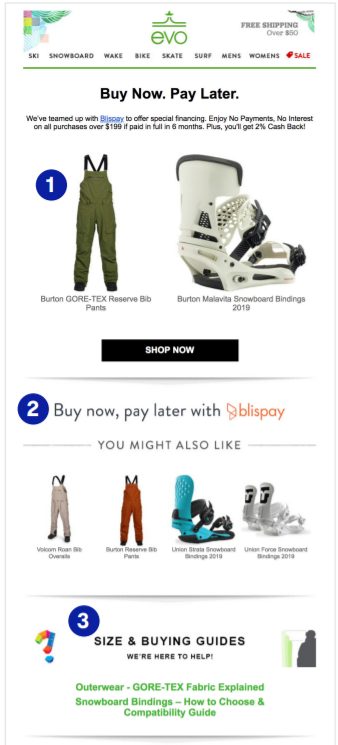
There are three key elements to pay attention to in this email:
- Evo resurfaces the products the individual customer browsed before leaving the site.
- They calculated if this consumer is likely to use financing services, then provided personalized recommendations for high-ticket items in a category in which they’re interested.
- Evo provides a sizing guide for both GORE-TEX products and snowboard bindings based on a customer’s previous interests.
By combining these three tactics, Evo can convince more casual browsers to make high-value purchases.
Dermstore
Dermstore is an eCommerce retailer that offers products from hundreds of beauty brands, including skin care, hair care and makeup products. Dermstore knows that skincare products only last for a limited time and shoppers are likely to return to make a similar purchase. For that reason, they put together a personalized replenishment campaign. Let’s take a closer look.
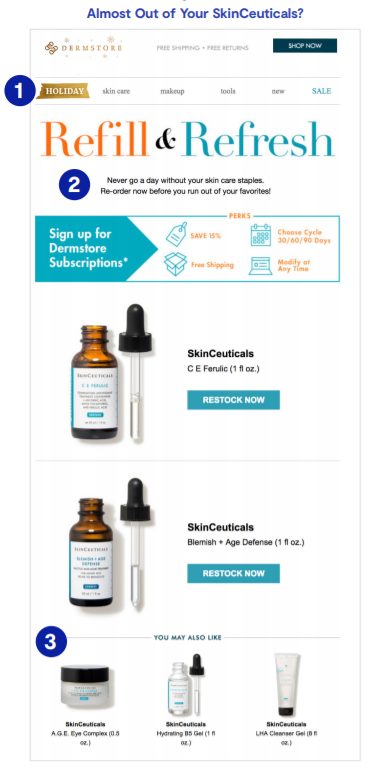
There are three notable instances of personalization in this email:
- The replenishment campaign uses automation to personalize send times based on each customer’s individual buying cadence.
- The email invokes urgency, while directly calling out that the customer tends to buy skincare products.
- They provide additional personalized product recommendations to expand the customer’s order size.
The fact that Dermstore measures each customer’s individual buying cadence is significant. Far too often, retailers base their replenishment emails on a product’s average lifetime, but this doesn’t account for the unique ways customers use products. By personalizing their replenishment emails in this way, Dermstore is sure to net more sales.
Timberland
Timberland is a US-based manufacturer and retailer best known for their sturdy and fashionable outdoor footwear. In their cart abandonment campaigns, Timberland uses predicted affinity to better encourage customers to complete their purchase. Let’s take a closer look:
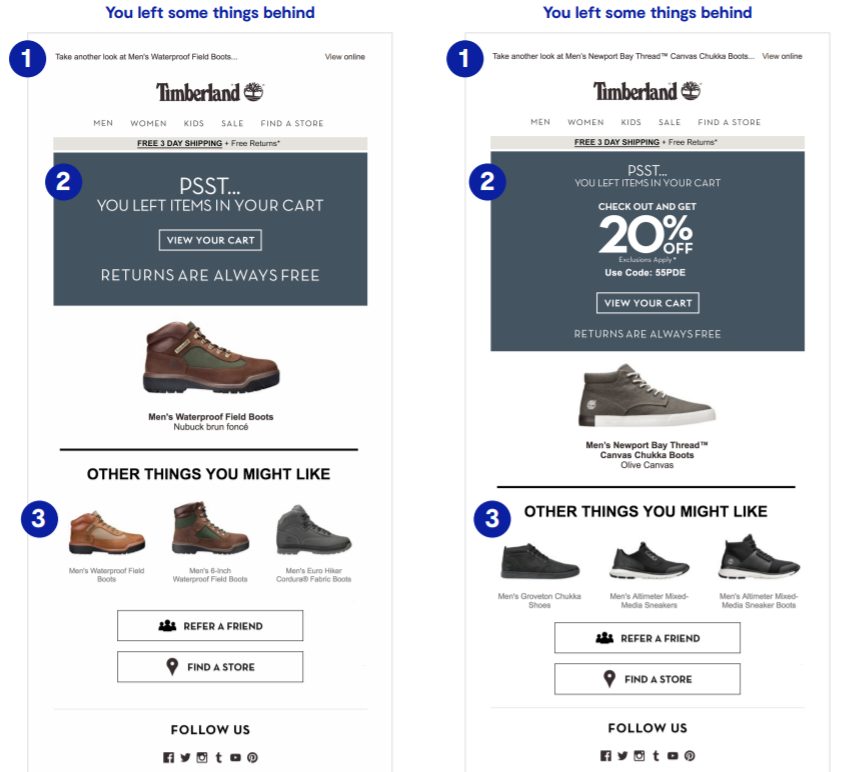
The above image illustrates Timberland’s expertise with personalized email outreach. Let’s examine the three dimensions outlined:
- Directly calls out the product customers looked at in the snippet text.
- Provides different “come back” messaging depending on discount affinity, only providing discounts to customers that need them.
- Includes dynamic product recommendations in the center of the email in case the shopper wants to change their order or add another item.
By combining these three factors, Timberland is far more likely to encourage customers to finish their purchase – and even expand their order size.
Email personalization starts here
Personalization has a proven positive effect on almost every channel it touches, and email is no exception. And with email being a top revenue-driver for many retailers, it’s crucial to invest in retail-specific email personalization solutions. This means finding a partner that takes both a product and customer-focused approach instead of forcing you to choose one or the other.
Once your team is using the right technology and best practices to create personalized emails, there’s only two things left to do – start sending smarter emails and start seeing results.


